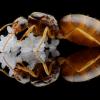Thank you guys, any help would be appreciated. ~Loki
1. Location of collection: Ulster county, ny, us
2. Date of collection: 5/18/18
3. Habitat of collection: deep under a rock
4. Length (from head to gaster): workers ~2mm, no bigger than 3mm for sure
5. Color, hue, pattern and texture: black, light brown in photos? Kind of striped gaster which is pointed, instead of completely round.
6. Distinguishing characteristics:
7. Distinguishing behavior:
8. Nest description: a rock that went about 6in-12in into the ground. When I lifted it up and out, these workers were there and carting these larvae things away so I scooped some up.
9. Nuptial flight time and date: n/a
Some good shots of the 'larvae' if they are:



Top/clearer view of unknown workers:

Edited by StayLoki, May 21 2018 - 11:20 AM.



















